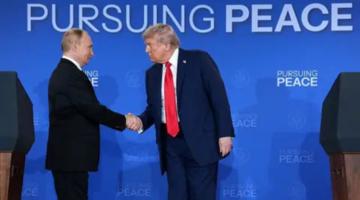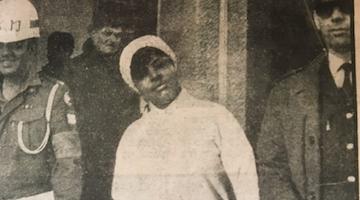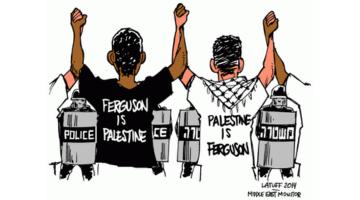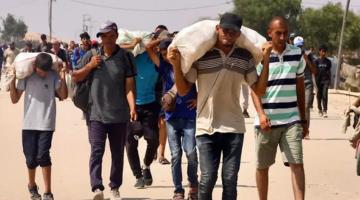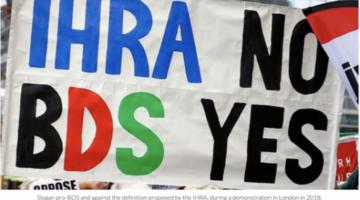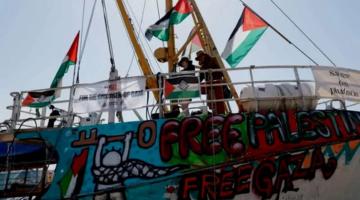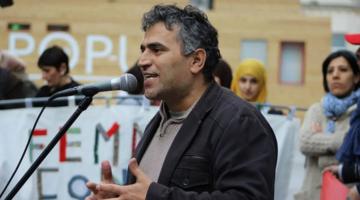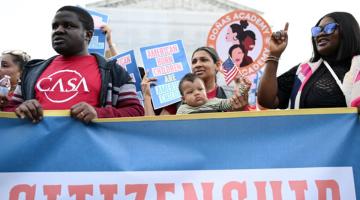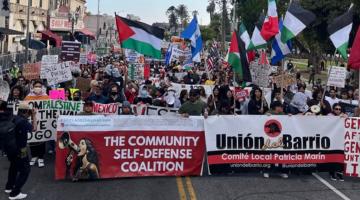Following the Al-Aqsa flood, media reports blamed the Palestinian resistance for well over one thousand deaths. As the dust settles, reports have since emerged indicating that the IDF killed civilians in multiple cases.
Originally published in FAIR.
Since October, the Israeli press has uncovered damning evidence showing that an untold number of the Israeli victims during the October 7 Hamas attack were in fact killed by the IDF response.
While it is indisputable that the Hamas-led attackers were responsible for many Israeli civilian deaths that day, reports from Israel indicate that the IDF in multiple cases fired on and killed Israeli civilians. It’s an important issue that demands greater transparency—both in terms of the questions it raises about IDF policy, and in terms of the black-and-white narrative Israel has advanced about what happened on October 7, used to justify its ongoing assault on the Gaza Strip.
Indeed, IDF responsibility for Israeli deaths has been a repeated topic of discussion in the Israeli press, accompanied by demands for investigations. But the most US readers have gotten from their own press about the issue is a dismissive piece from the Washington Post about October 7 “truthers.”
Implementing the Hannibal Directive?
In the wake of October 7, after Israel began its genocidal campaign against Gaza, reports began to emerge from the Israeli press of incidents in which Israeli troops made decisions to fire on Hamas targets regardless of whether Israeli civilians were present.
That the IDF’s initial reaction was chaotic at best is well-documented. Much of the early military response came from the air, with little information for pilots and drone operators to distinguish targets but orders to shoot anyway (Grayzone, 10/27/23). Citing a police source, Haaretz (11/18/23) reported that at the Supernova music festival site, “an IDF combat helicopter that arrived to the scene and fired at terrorists there apparently also hit some festival participants.” But there are also mainstream Israeli media reports that credibly suggest the IDF may have implemented a policy to sacrifice Israeli hostages.
Supernova music festival attendee Yasmin Porat had escaped the festival on foot to the nearby village of Be’eri, only to be held hostage in a home with 13 others. One of the captors surrendered and released Porat to IDF troops outside. She described how, after a prolonged standoff, Israeli tank fire demolished that home and killed all but one of the remaining Israeli hostages. Her account was verified by the other surviving hostage (Electronic Intifada, 10/16/23; Haaretz, 12/13/23). One of the Israeli victims was a child who had been held up as an example of Hamas’s brutality (Grayzone, 11/25/23).
Yedioth Ahronoth (1/12/24; translated into English by Electronic Intifada, 1/20/24)—one of Israel’s most widely read newspapers—published a bombshell piece that put these revelations in context. The paper reported that the IDF instructed its members
to stop “at any cost” any attempt by Hamas terrorists to return to Gaza, using language very similar to that of the original Hannibal Directive, despite repeated promises by the defense apparatus that the directive had been canceled.
The Hannibal Directive—named for the Carthaginian general who allegedly ingested poison rather than be captured by his enemies—is the once-secret doctrine meant to prevent at all costs the taking of IDF soldiers as hostages, even at the risk of harming the soldier (Haaretz, 11/1/11). It was supposedly revoked in 2016, and was ostensibly never meant to be applied to civilians (Haaretz, 1/17/24).
Yedioth Ahronoth reported:
It is not clear at this stage how many of the captives were killed due to the operation of this order on October 7. During the week after Black Sabbath [i.e., October 7] and at the initiative of Southern Command, soldiers from elite units examined some 70 vehicles that had remained in the area between the Gaza Envelope settlements and the Gaza Strip. These were vehicles that did not reach Gaza because on their way they had been hit by fire from a helicopter gunship, a UAV or a tank, and at least in some of the cases, everyone in the vehicle was killed.
Reports that the IDF gave orders to disregard the lives of Israeli captives have caused great consternation in Israel (Haaretz, 12/13/23). An author of the IDF ethics code called it “unlawful, unethical, horrifying”(Haaretz, 1/17/23). Yet any mention of the reports, or the debates they have inspired in Israel, seems to be virtually taboo in the mainstream US media.
The only mention of “Hannibal directive” FAIR could find in a major US newspaper the since October 7 came in a New York Post article (12/18/23) paraphrasing a released hostage who
claimed that Hamas told them the Israel Defense Forces would employ the infamous “Hannibal Directive” on civilians, a revoked protocol that once allegedly called on troops to prioritize taking out terrorists even if it meant killing a kidnapped soldier.
‘A general’s dilemma’
A version of Supernova attendee Porat’s account was related a few days later in the New York Times (12/22/23), which published a lengthy investigative report piecing together what happened across the village of Be’eri. That report included a section about the standoff at the house where Porat was held, under the subhead “A General’s Dilemma.” It did not mention Porat’s prior revelations in Israeli media and the controversy they had caused.
The piece described how
the captors had forced roughly half of the hostages, including the Dagans, into Ms. Cohen’s backyard. They positioned the hostages between the troops and the house, according to Ms. Dagan and Ms. Porat.
After more than an hour of gunfire between the IDF and the gunmen, Ms. Dagan reported seeing at least two hostages in the backyard “killed in the gunfire. It wasn’t clear who killed them, she said.”
The article continued:
As the dusk approached, the SWAT commander and General [Barak] Hiram began to argue. The SWAT commander thought more kidnappers might surrender. The general wanted the situation resolved by nightfall.
Minutes later, the militants launched a rocket-propelled grenade, according to the general and other witnesses who spoke to the Times.
”The negotiations are over,” General Hiram recalled telling the tank commander. ”Break in, even at the cost of civilian casualties.”
The tank fired two light shells at the house.
Shrapnel from the second shell hit Mr. Dagan in the neck, severing an artery and killing him, his wife said.
During the melee, the kidnappers were also killed.
Only two of the 14 hostages—Ms. Dagan and Ms. Porat—survived.
It’s a shocking order; it’s also shocking that the Times offered no comment about the order. After the revelation caused a firestorm in Israel, including demands for an immediate investigation by family of those killed in the incident, the Times (12/27/23) published a follow-up about how General Hiram’s quote “stirred debate,” including multiple quotes from the general’s defenders.
While it is indisputable that the Hamas-led attackers were responsible for many Israeli civilian deaths that day, reports from Israel indicate that the IDF in multiple cases fired on and killed Israeli civilians. It’s an important issue that demands greater transparency—both in terms of the questions it raises about IDF policy, and in terms of the black-and-white narrative Israel has advanced about what happened on October 7, used to justify its ongoing assault on the Gaza Strip.
Indeed, IDF responsibility for Israeli deaths has been a repeated topic of discussion in the Israeli press, accompanied by demands for investigations. But the most US readers have gotten from their own press about the issue is a dismissive piece from the Washington Post about October 7 “truthers.”
Implementing the Hannibal Directive?
In the wake of October 7, after Israel began its genocidal campaign against Gaza, reports began to emerge from the Israeli press of incidents in which Israeli troops made decisions to fire on Hamas targets regardless of whether Israeli civilians were present.
That the IDF’s initial reaction was chaotic at best is well-documented. Much of the early military response came from the air, with little information for pilots and drone operators to distinguish targets but orders to shoot anyway (Grayzone, 10/27/23). Citing a police source, Haaretz (11/18/23) reported that at the Supernova music festival site, “an IDF combat helicopter that arrived to the scene and fired at terrorists there apparently also hit some festival participants.” But there are also mainstream Israeli media reports that credibly suggest the IDF may have implemented a policy to sacrifice Israeli hostages.
Supernova music festival attendee Yasmin Porat had escaped the festival on foot to the nearby village of Be’eri, only to be held hostage in a home with 13 others. One of the captors surrendered and released Porat to IDF troops outside. She described how, after a prolonged standoff, Israeli tank fire demolished that home and killed all but one of the remaining Israeli hostages. Her account was verified by the other surviving hostage (Electronic Intifada, 10/16/23; Haaretz, 12/13/23). One of the Israeli victims was a child who had been held up as an example of Hamas’s brutality (Grayzone, 11/25/23).
Yedioth Ahronoth (1/12/24; translated into English by Electronic Intifada, 1/20/24)—one of Israel’s most widely read newspapers—published a bombshell piece that put these revelations in context. The paper reported that the IDF instructed its members
to stop “at any cost” any attempt by Hamas terrorists to return to Gaza, using language very similar to that of the original Hannibal Directive, despite repeated promises by the defense apparatus that the directive had been canceled.
The Hannibal Directive—named for the Carthaginian general who allegedly ingested poison rather than be captured by his enemies—is the once-secret doctrine meant to prevent at all costs the taking of IDF soldiers as hostages, even at the risk of harming the soldier (Haaretz, 11/1/11). It was supposedly revoked in 2016, and was ostensibly never meant to be applied to civilians (Haaretz, 1/17/24).
Yedioth Ahronoth reported:
It is not clear at this stage how many of the captives were killed due to the operation of this order on October 7. During the week after Black Sabbath [i.e., October 7] and at the initiative of Southern Command, soldiers from elite units examined some 70 vehicles that had remained in the area between the Gaza Envelope settlements and the Gaza Strip. These were vehicles that did not reach Gaza because on their way they had been hit by fire from a helicopter gunship, a UAV or a tank, and at least in some of the cases, everyone in the vehicle was killed.
Reports that the IDF gave orders to disregard the lives of Israeli captives have caused great consternation in Israel (Haaretz, 12/13/23). An author of the IDF ethics code called it “unlawful, unethical, horrifying” (Haaretz, 1/17/23). Yet any mention of the reports, or the debates they have inspired in Israel, seems to be virtually taboo in the mainstream US media.
The only mention of “Hannibal directive” FAIR could find in a major US newspaper the since October 7 came in a New York Post article (12/18/23) paraphrasing a released hostage who
claimed that Hamas told them the Israel Defense Forces would employ the infamous “Hannibal Directive” on civilians, a revoked protocol that once allegedly called on troops to prioritize taking out terrorists even if it meant killing a kidnapped soldier.
‘A general’s dilemma’
A version of Supernova attendee Porat’s account was related a few days later in the New York Times (12/22/23), which published a lengthy investigative report piecing together what happened across the village of Be’eri. That report included a section about the standoff at the house where Porat was held, under the subhead “A General’s Dilemma.” It did not mention Porat’s prior revelations in Israeli media and the controversy they had caused.
The piece described how
the captors had forced roughly half of the hostages, including the Dagans, into Ms. Cohen’s backyard. They positioned the hostages between the troops and the house, according to Ms. Dagan and Ms. Porat.
After more than an hour of gunfire between the IDF and the gunmen, Ms. Dagan reported seeing at least two hostages in the backyard “killed in the gunfire. It wasn’t clear who killed them, she said.”
The article continued:
As the dusk approached, the SWAT commander and General [Barak] Hiram began to argue. The SWAT commander thought more kidnappers might surrender. The general wanted the situation resolved by nightfall.
Minutes later, the militants launched a rocket-propelled grenade, according to the general and other witnesses who spoke to the Times.
”The negotiations are over,” General Hiram recalled telling the tank commander. ”Break in, even at the cost of civilian casualties.”
The tank fired two light shells at the house.
Shrapnel from the second shell hit Mr. Dagan in the neck, severing an artery and killing him, his wife said.
During the melee, the kidnappers were also killed.
Only two of the 14 hostages—Ms. Dagan and Ms. Porat—survived.
It’s a shocking order; it’s also shocking that the Times offered no comment about the order. After the revelation caused a firestorm in Israel, including demands for an immediate investigation by family of those killed in the incident, the Times (12/27/23) published a followup about how General Hiram’s quote “stirred debate,” including multiple quotes from the general’s defenders.
Ignoring the context
There was another rare mention of Israeli friendly fire in New York Times (1/5/24), reporting on Palestinian Jerusalem resident Soheib Abu Amar, who was also held hostage and ultimately killed in the house Porat escaped from. Bizarrely, it did not mention the controversy over Hiram’s order.
Under the headline, “A Palestinian Man Vanished October 7. His Family Wants to Know Who Killed Him,” the Times traced Abu Amar’s disappearance that day, which began as a bus driver for partygoers at the music festival. Describing his final moments, the Times wrote that “Israeli security forces engaged in an intense battle with Hamas terrorists at the home” in which nearly “all of the hostages were killed.” It later mentioned that “families of the hostages…want an investigation to begin immediately,” but made no mention of Hiram’s order.
None of these Times articles put the Be’eri incident in the context of the Israeli press reports of other “friendly fire” incidents, and no other Times reporting has mentioned them, either, leaving the impression that the Hiram order was an isolated incident.
This is especially remarkable, given that one of the reporters on the Yedioth Ahronoth story, Ronen Bergenen, is also a New York Times contributor, and shared the byline on the Times‘ Be’eri investigation. His Yedioth Ahronoth revelations have yet to be mentioned in the Times, or elsewhere in US corporate media.
‘A small but growing group’
Meanwhile, the first time the Washington Post (1/21/24) made any mention of the controversies, it did so indirectly, and only to dismiss them by conflating them with conspiracy theories. Under the headline “Growing October 7 ‘Truther’ Groups Say Hamas Massacre Was a False Flag,” Post “Silicon Valley correspondent” Elizabeth Dwoskin attacked “truthers” who question the Israeli narrative of October 7, equating them with Holocaust deniers.
The Post’s first subject was a woman named Mirela Monte, who subscribed to a Telegram channel called Uncensored Truths. This convinced her that October 7 was a “’false flag’ staged by the Israelis—likely with help from the Americans—to justify genocide in Gaza.” The Post reported that the channel had nearly 3,000 subscribers, but despite this relatively miniscule reach, still used it as its lead example of dangerous misinformation.
Another target was an anonymous poster on the niche subreddit r/LateStageCapitalism, who claimed that “the Hamas attack was a false flag for Israel to occupy Gaza and kill Palestinians.” Though this is an internet forum largely consisting of memes, the Post described the subreddit as “a community of left-wing activists.”
These were held up as examples of a “small but growing group” that “denies the basic facts of the attacks,” pushes “falsehoods” and “misleading narratives” that “minimize the violence or dispute its origins.” The Post cited a seemingly random woman at a protest who claimed that “Israel murdered their own people on October 7”—linking her to “some in the crowd” who allegedly shouted “antisemitism isn’t real.”
But the Post avoided any attempt to address the empirical question of whether Israel killed any of its own on October 7. Dwoskin’s only reference to the reports from Israel come in a paragraph meant to downplay that question:
Israeli citizens have accused the country’s military of accidentally killing Israeli civilians while battling Hamas on October 7; the army has said it will investigate.
Dwoskin’s framing suggests these are minor concerns that are being appropriately dealt with. But those accusations are not of accidental killings, but of deliberate choices to treat Israeli civilians as expendable. And an internal army investigation is not the same as an independent investigation.
Moreover, the IDF only agreed to investigate the Be’eri incident, not the question of whether the Hannibal Directive was issued—and only after press scrutiny and public pressure, demonstrating the importance of having journalists willing to challenge those in power rather than covering up for them, as Dwoskin’s article did.
Attacking independent journalism
Dwoskin continued by attacking independent media outlets that have been covering the story: “But articles on Electronic Intifada and Grayzone exaggerated these claims to suggest that most Israeli deaths were caused by friendly fire, not Hamas.”
Electronic Intifada and the Grayzone are among the few outlets that have exposed English-language audiences to the reporting from Israel about the IDF’s attacks on Israeli civilians on October 7. To criticize Grayzone‘s reporting (10/27/23), the Post cited the director of “an Israeli watchdog organization dedicated to fighting disinformation,” who said that Grayzone “distorts” a helicopter pilot’s account of having trouble “distinguishing between civilians and Hamas.”
On the word “distorts,” Dwoskin hyperlinked to a Haaretz op-ed (11/27/23) attacking Grayzone editor Max Blumenthal’s reporting. That piece accused him misusing ellipses when he quoted the pilot from the Ynet piece who said there was “tremendous difficulty in distinguishing within the occupied outposts and settlements who was a terrorist and who was a soldier or civilian.”
Haaretz complained that Blumenthal’s ellipses left out a statement from the pilot: “A decision was made that the first mission of the combat helicopters and the armed drones was to stop the flow of terrorists and the murderous mob that poured into Israeli territory through the gaps in the fence.” Blumenthal, the paper complained, ignored that “the pilots were assigned a different task: stopping the terrorists flowing in from Gaza,” and that there was “no ambiguity in this task.”
However, this is entirely consistent with Blumenthal’s claim that “the pilots let loose a fury of cannon and missile fire onto Israeli areas below.” Given that hundreds of hostages were concurrently being taken from Israel into Gaza, there was a great deal of “ambiguity” in the task of “stop[ping] the flow of terrorists…through the gaps in the fence.” It’s highly relevant that the pilot said it was very difficult to distinguish “who was a terrorist and who was a soldier or civilian,” and that only later did the IDF “carefully select the targets.”
The Haaretz piece made several other dubious accusations, including charging Blumenthal with using “biased language” when he described Hamas as “militants” and “gunmen”—terms chosen by many establishment news outlets precisely to avoid bias (AP on Twitter, 1/7/21; BBC, 10/11/23).
The op-ed also accused Blumenthal of omitting “everything related to the war crimes committed by Hamas terrorists,” ignoring his clear statement in his article that “video filmed by uniformed Hamas gunmen makes it clear they intentionally shot many Israelis with Kalashnikov rifles on October 7.”
The Post offered no example of the Grayzone claiming “most” Israeli deaths were caused by friendly fire, and FAIR could find no such claims in the outlet’s October 7 coverage. It has, however, reported extensively on the friendly fire reports in Israeli media that the Post has so studiously avoided.
Hiding the accusations
The independent Palestinian-run outlet Electronic Intifada has also based its reporting on articles and interviews from the Israeli press (e.g., Ynet, 10/15/23; Haaretz, 10/20/23, 11/9/23, 11/18/23; Times of Israel, 11/9/23). The Washington Post, however, only wrote that EI senior editor Asa Winstanley was “basing the story, in part, on a YouTube clip (10/15/23) of a man who describes himself as a former Israeli general.”
As Winstanley noted in his response to Dwoskin, “‘Graeme Ipp’ described himself—and actually was—an Israeli major, as I explain in detail in the piece itself.” The Post did not link to the article, video or give any citation to help readers find the article in question, which served to conceal the blatant misquotation.
The Post also misquoted Winstanley to claim he wrote that “most” of the Israeli civilians were killed by the Israeli military that day. In reality, Winstanely (Electronic Intifada, 11/23/23) wrote that Ipp’s testimony was confirmation that “Israel killed many, if not most, of the civilians that died during the Palestinian offensive.”
Had the Post actually pointed its readers to the reporting from the Grayzone and Electronic Intifada, readers may have been able to more easily understand Dwoskin’s distortions. But discrediting those outlets serves an important political purpose: Along with Mondoweiss, they are some of the only English-language outlets that have covered the bombshell revelations that appear frequently within the Israeli press. Attacking their reporting hides from US public view the numerous accusations of deliberate mishandling of intelligence and mass killing by the IDF of its own civilians.
Holocaust denial?
A sizable chunk of the Washington Post‘s article centered on interviews with pro-Israel “experts” linking October 7 “truthers” to Holocaust denialism, or promoting “internet-driven conspiracy theories.” Dwoskin cited Emerson Brooking, a researcher from the NATO-affiliated Atlantic Council think tank, who warned that “the long tail of Holocaust denial is a lesson in what may happen to October 7.”
Dismissing any actual investigation into the facts, Brooking says, “It’s generally indisputable that Hamas did something—the pro-Hamas camp can’t erase that entirely.” He never specifies what that “something” was—the exact issue in question. Instead, he assumes that “something” is settled fact, and that anyone who investigates it is trying to “chip away at it” in an attempt at “rewriting…history.”
The Post equates people questioning the Holocaust—which has a factual record established over decades of international investigations, scholarship and research—with questioning the details of what Hamas called the Al Aqsa Flood, which has only ever been investigated by the Israeli government. That government, it should be recalled, has a documented record of blatantly lying and fabricating evidence.
Israel’s justification for its relentless assault upon Gaza has depended in large part upon its narrative. Since October 7, the Israeli government has blocked or rejected any serious international inquiry into the attacks or the IDF response. The US government has declined to call for or engage in any investigation.
On the other hand, in a recent statement, Hamas—which maintains that the Al Aqsa Flood was a military, not a terror, operation—has publicly agreed to cooperate with an international investigation into its own war crimes (Palestine Chronicle, 1/21/24).
Many of the most lurid claims that mobilized public opinion in support of Israel’s attack (e.g., 40 beheaded babies, babies cooked in ovens, etc.) have since been debunked and disproven (Mondoweiss, 2/1/24). In fact, Haaretz (11/18/23) revealed that Hamas had no prior knowledge of the festival they were accused of targeting.
Israeli and US officials repeatedly attribute all civilian deaths to Hamas, even though this is certainly false. Clearly, then, some Israeli civilian casualties have been “blame[d] on another party.”
How many Israeli civilians were actually killed by Hamas, and how many by Israel? Was the Al Aqsa Flood a terrorist attack designed to kill as many civilians as possible? These are important questions that have yet to be conclusively and independently answered, but the Washington Post seems to want to dissuade people from even asking them. In evoking the specter of Holocaust denial, Dwoskin and the Post are not defending the truth, but attempting to protect readers from it.
Bryce Greene is a writer based in Indiana.

